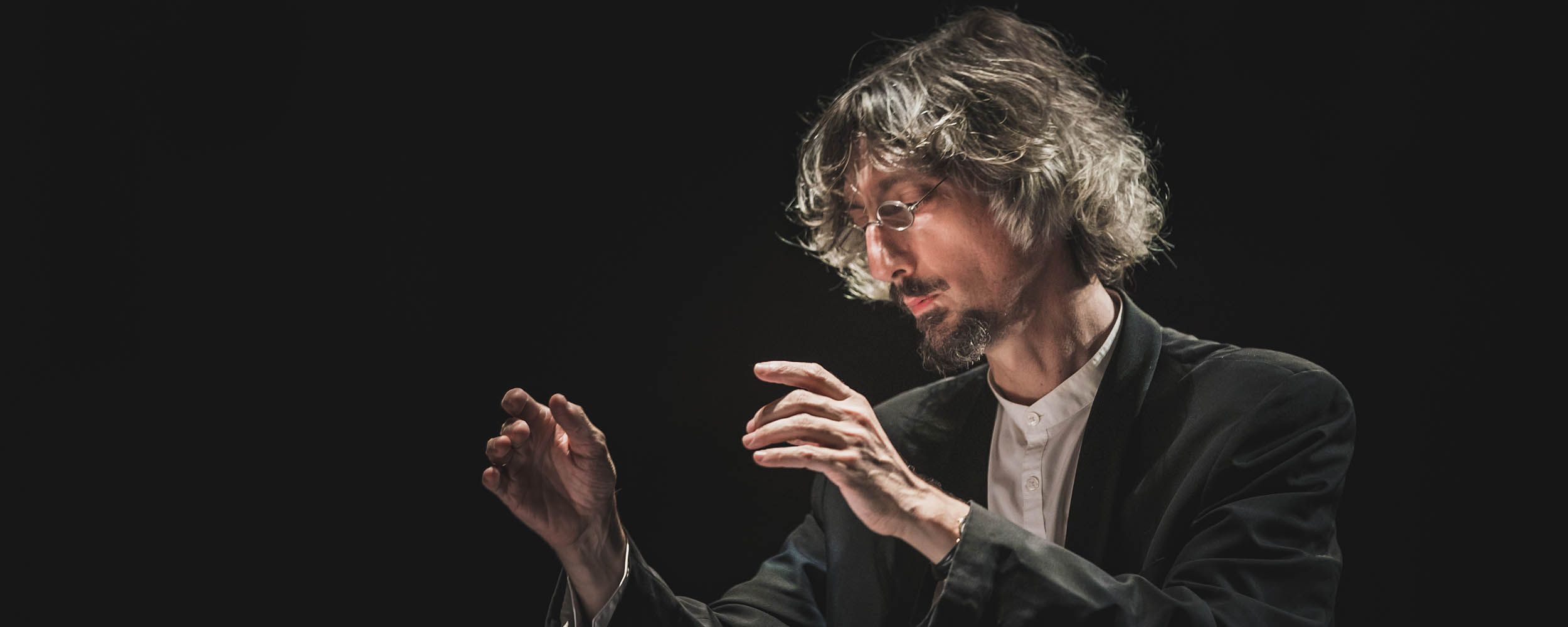Maestro Federico Maria Sardelli and soprano Bruno de Sá in concert at the Maggio: Friday 15 November, 8 pm, Mehta Hall

On Friday, November 15th 2024, at 8 pm, on the podium of the Zubin Mehta Hall, the return of maestro Federico Maria Sardelli, leading the Maggio Orchestra.
With him Bruno de Sá, on his debut at Maggio.
On the program a selection of compositions by Johann Anton Filz, Wolfgang Amadeus Mozart, Luigi Cherubini and Carl Philipp Emanuel Bach.
We inform our kind audience that only few tickets for the “A Sector” are still available.
Florence, November 12th, 2024 - Federico Maria Sardelli conducts the Maggio Orchestra in the symphonic concert scheduled in the Mehta Hall on Friday, November 15th, at 8 pm. The maestro, returning on the podium of Maggio Musicale after the concert held in February 2023, is flanked with soprano Bruno de Sá, currently among the most famous performers in the world and on his debut at Maggio. De Sá, winner of prestigious and numerous awards and competitions, including the "Oper! Award 2020" and "Forum-Opéra Trophy 2022" as best debut, in the same year he released his first solo album, Roma travestita, achieving a great success of public and critics; he also obtained the first place at the "Österreichischer Musiktheaterpreis 2024". His second soloist album, also enthusiastically received, was released a few months ago and is dedicated to Mozart and his contemporaries; he has also made numerous tours in Europe, collaborating with famous ensembles such as "The Golden Apple", "Les Accents", "New Baroque" and "Ensemble 1700".
On the programme an interesting selection of compositions from the second half of the 18th century, united by a style that is defined as “gallant” for his expressive measure and balance, synonymous at the time with "good taste". The concert starts with "Symphony Op. II, n. 2 in G minor" by Johann Anton Filz, the only symphony written by the author in minor key where you can hear distinctly the recalls to Vivaldi and Giovanni Battista Sammartini, charismatic figure of the symphonic tradition of Milan.
The following is "Lungi da te", an excerpt from Mitridate, re di Ponto by Wolfgang Amadeus Mozart: first serious opera composed by the genius of Salzburg, the aria is the sad farewell of Prince Sifare (Mitridate’s son) from the beloved Aspasia, bride of the protagonist of the story.
The concert continues with the aria " Non cercar per ora… La gran vendetta ancora ", from Il Mesenzio, re d'Etruria by Luigi Cherubini, opera first performed in Florence in September 1782: in this opening air of the character of Lauso - prince of Preoreste - «No, non cercar per ora…», the broad passages of ‘bravura’ serve as a traditional vehicle for the feelings of revenge that, in this case, push the prince prisoner towards the regicide project against Mesenzio.
It then continues with the "Symphony in D major Wq 176, H 651" by Carl Philipp Emanuel Bach: of the symphonies written during his stay at the court of Berlin is perceived, just as in this case, a sonorous opulence and solemnity still strongly linked to the Baroque poetics.
At the end of the concert two more compositions by Wolfgang Amadeus Mozart: Exultate, jubilate, motet written in 1773 specifically for the castrato Venanzio Rauzzini - who had played the role of Cecilio in the staging of the opera Lucio Silla at the Teatro Regio Ducale in Milan the year before - and the "Symphony n. 39 in E flat major K. 543"; before the three great symphonies written by Mozart in the summer of 1788 (together with Symphony no. 40 and the famous symphony no. 41 named Jupiter) originally conceived to be included in the programme of a series of concerts by subscription, then called 'academies', which however, as far as is known, never took place.
The concert:
A journey back in the music of the second half of the eighteenth century, between pages written for famous castrati of the time, famous symphonies and true rarities of listening.
Born in Bavaria in 1733, Johann Anton Filtz was a cello virtuoso and composer of great esteem at the time.
After being a pupil of Johann Stamitz, in 1754 he joined the court orchestra of Mannheim, an excellent team known for its attention to dynamic effects and contrasts between sound planes. For this he produced numerous concerts and symphonies, including the Symphony in G minor op. II n. 2, printed in 1760, which reveals the influence of the Baroque model in the plant and style, especially vivaldian.
In 1770, during his first trip to Italy, the fourteen-year-old Mozart produced for the Teatro Regio Ducale of Milan his first serious opera: Mitridate, re di Ponto. Despite his young age, Mozart was well aware of the rules to be followed in opera, first of all that of shaping the arias on the vocal characteristics of the singers available. The aria «Lungi da, te mio bene», which describes the poignant farewell of prince Sifare to beloved Aspasia in the second act, was made for the voice of the castrated Pietro Benedetti (called the Sartorino), known for the delicacy in sound emission.
Only two years later, and still for the Teatro Regio Ducale in Milan, Mozart would produce a new serious opera, Lucio Silla. The opera, which premiered on 26 December 1772, had as its cast, in the role of Cecilio, the famous Venanzio Rauzzini, who was also admired by Leopold Mozart for his angelic and crystalline voice. For him the young Salzburg composer also made the motet Exsultate, jubilate, a page marked by a particularly virtuosic writing of an exquisitely theatrical matrix, perfectly congenial to the vocal qualities of his first interpreter.
Even the young Luigi Cherubini, a Florentine musician trained by Giuseppe Sarti, in his fourth opera Mesenzio re d'Etruria writes the part of Lauso thinking about the singing style of the one who would play the role of the prince. In the cast of the opera, which premiered on 6 September 1782 at the Teatro della Pergola in Florence, there was indeed the castrato Francesco Porri, famous for his skill in sudden passages between vocal registers. Lauso’s opening air in the first act, «No, don’t try for now», is distinguished by the numerous jumps and wide color passages, able to emphasize the feelings of revenge that initially animate the prince.
Carl Philipp Emanuel Bach, the fifth and most famous of Johann Sebastian’s sons, was a composer and court harpsichordist in Berlin and Hamburg and a musician particularly loved by Haydn and Mozart. In addition to a considerable corpus of works for keyboard, Carl Philipp Emanuel also composed instrumental works for various organis and some symphonies, including the Symphony in D major Wq 176 made in 1755 while he was in the service of Federico Il Grande. Like the other Symphonies made for the Prussian court, also the Symphony in D major is linked to the Baroque poetics both in the setting, with the alternation between instrumental groups typical of the Concerto grosso, and in the style, characterized by solemnity and sonorous opulence, although there are already some elements of harmonic discontinuity which the author will focus on in the following years.
Before the last three symphonies by Mozart, the Symphony in E flat major K. 543 was composed in June 1788. For Mozart that year was really difficult on the personal side - between the worries due to a disastrous economic situation and the disappointment suffered by the failure of the Viennese success of Don Giovanni - but also fruitful on the side of creativity. In that summer, under the burning impulse of his talent, Mozart gave birth to three symphonic masterpieces that close his production in the genre and represent the summa of his orchestral art. In the Symphony K. 543 for the first time Mozart uses instead of oboes clarinets, instruments that at the time did not yet have a stable arrangement in orchestra but were particularly loved by the composer for the soft and pasty timbre. Following the venerable model of Haydn, the Symphony opens with an imposing introductory Adagio: vigorous chords followed by ascending scales and descending loads of tension open the way to the first theme of the Allegro, which from the beginning almost enters on tiptoe to then take strength supported by trumpets and timpani. The Andante is built on a theme of serene cantability, but unexpectedly takes at its center dark and dramatic colors. Followed by a Minuet with an imperious step that gives way in the Trio to the graceful dialogue between the flute and the pair of clarinets. The closing, on the other hand, is sparkling with the unstoppable momentum of the theme of the final Allegro that bounces without stopping between the various orchestral families.



